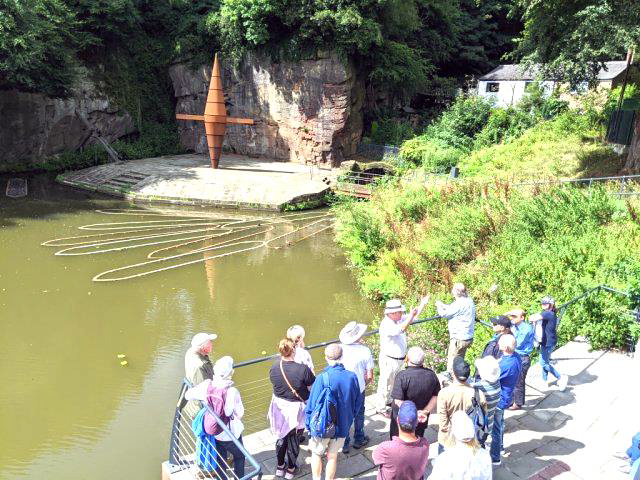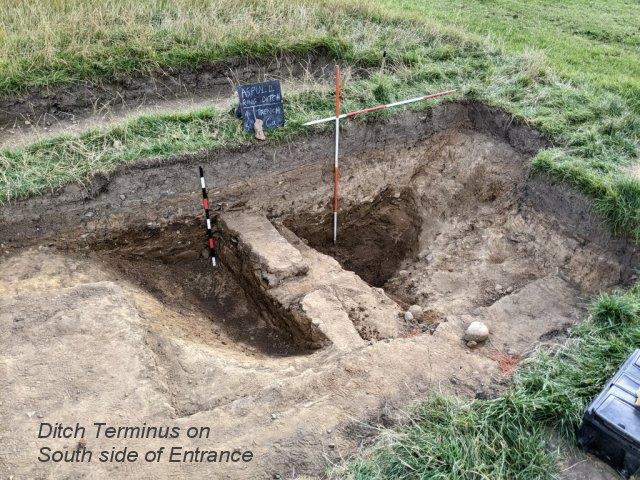
Great turnout for this trip, with over twenty of us meeting on 'The Green' at Worsley for a guided tour by Manchester's most renowned industrial archaeologist, Dr Mike Nevell. For many years Mike was based at the University of Manchester's Archaeology Unit and later becoming Head of the Centre for Applied Archaeology at Salford University. He is now the Industrial Heritage Support Officer for Historic England at Ironbridge Gorge Museum.
We all met at the monument to Fracis Egerton, the 3rd Duke of Bridgewater. He was the man responsible for the whole coal mining development in the Worsley area and is famous for commissioning the first industrial canal in Britain. Mike explained that the chocolate-box vista we see today belies the scene two and a half centuries ago when this area was a hive of industrial activity. Workshops, boatyards, cranes, forges, and later, railways and steam engines covered the area.
History - the Delph itself started life as a Medieval stone quarry but in the 17th century it was realised that the coal measures, which outcropped in the valley, could be exploited by digging a tunnel into the quarry side. Eventually though, due to rising water in the mines and transportation costs on the poor road system, further exploitation was prevented. The Duke's land agent, John Gilbert, however, came up with a solution to both problems - an underground canal which would be filled with water drained from the mines. In 1759 a bill was passed in Parliament and by 1761 the canal was built. By 1765 an over-ground section was completed, extending the system from the Delph basin into the heart of Manchester. Success - initially it was just to serve the domestic market but as and more and more steam driven mills sprung at the beginning of the 19th century, the demand for the Duke's coal became immense. At its height, a million tons of coal a year were being extracted from over 47 miles of tunnelling on three different levels. To relieve congestion a second tunnel was constructed at the Delph. Special boats were used to access the narrow tunnels (known as starvationer boats due to the internal ribs on display).
Decline - by the middle of the 19th century, shafts were being dug down to the mines in and around the Walkden area and, by the end of the century, the majority of the mining operations had moved to there. Most of the coal was now being transported by rail, thus making the industrial complex at Worsley redundant. It became derelict and an eyesore.
Recovery - at the beginning of the 20th century however, it was decided to re-landscape the whole area with all the industrial buildings being demolished. The Green was created that we see today, surrounded by a new housing development. Over the years, various schemes have attempted to clean up the Delph basin itself. In 2019 a £5.5m restoration plan was initiated, funded by the National Lottery Heritage, Salford council, and Bridgewater Canal Company. Now the area is a much-loved tourist attraction, enjoyed by canal users as well as walkers and cyclists, but how many are aware of its industrial heritage. You can see more images of our trip on our blog here.
Aspull Ring Ditch Progress

Since our last report, we have been able to open another four trenches. These are in the areas either side of what he have perceived to be the entrance - and sure enough we have been able to identify both terminals of the ring ditch, revealing an entrance width of around 6.5m. In addition to the trenches, coring with a 20mm auger is indicating the ring is anything but round. We're fairly sure now the site is Neolithic, either a henge monument or mortuary enclosure, although we will have to wait till the end of the month for the result from the C14 sample. More details of our progress as usual can be found on our website blog here.
Next Meeting
Wednesday 7th September - at the Real Crafty on Upper Dicconson Street starting at 7.30pm as usual. We're back in Rome this month with Graham Hanley telling us about some not so well-known sites in the Eternal City. His title is "Off the tourist trail - lesser-known monuments of Rome". Graham has made many trips there and has accumulated thousands of photos, so I'm confident he'll have some choice ones for his talk. Hope to see you then B.A.
|



